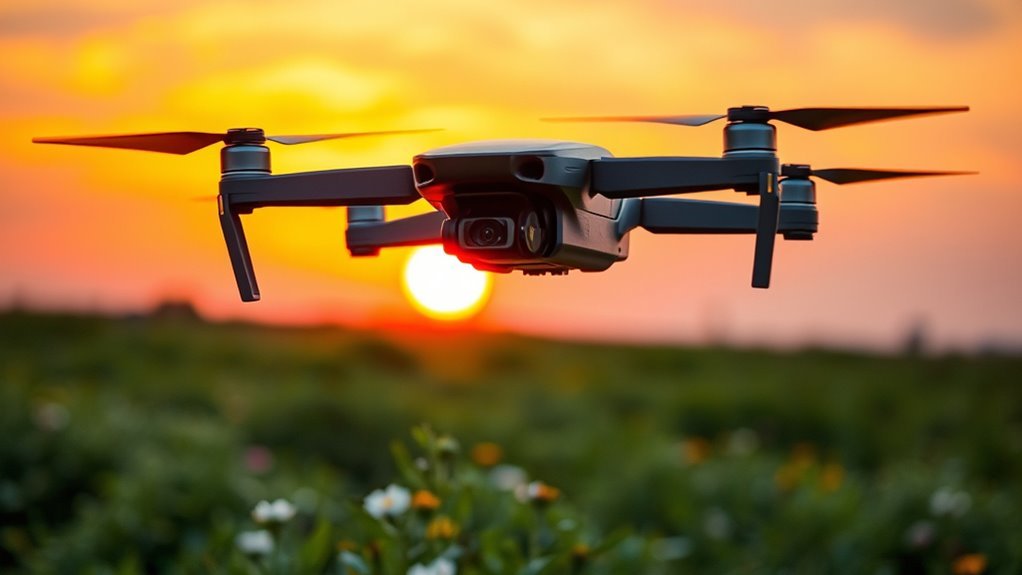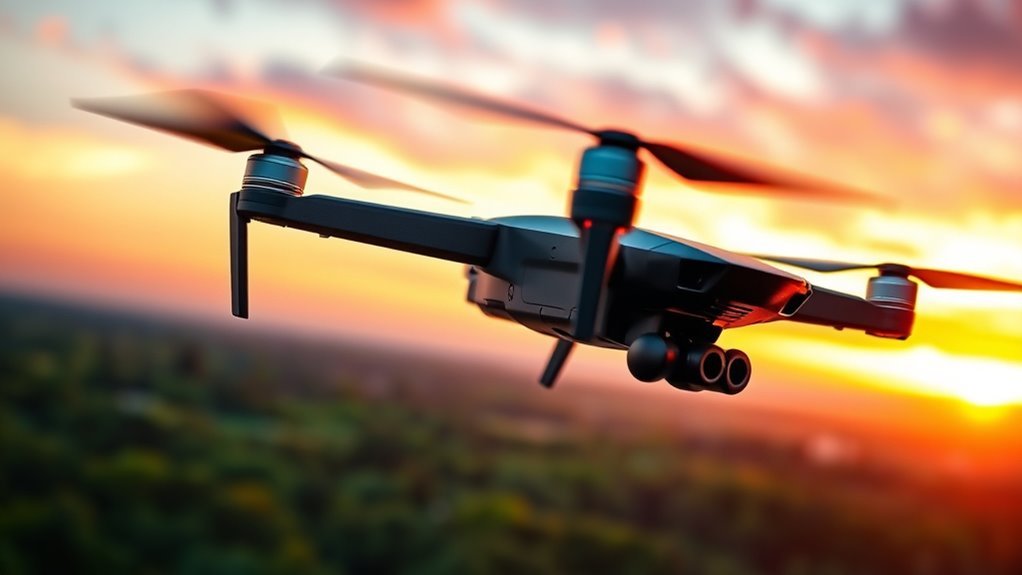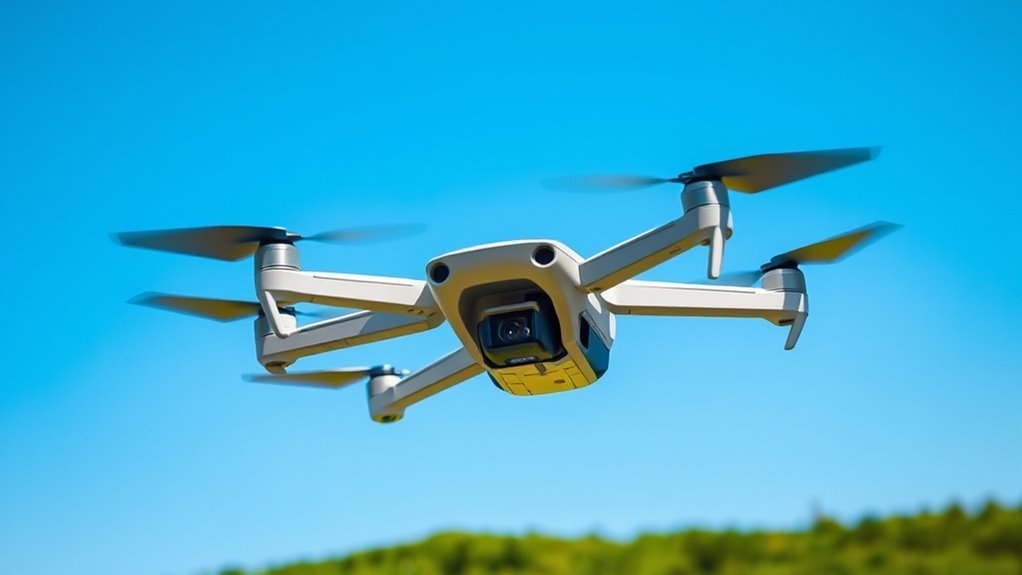If you’re considering the HS710 drone, you’ll find it offers a sturdy, compact design paired with reliable flight stability and a 2.7K camera that balances quality and storage demands. Its 20-minute battery life and intuitive hybrid controls suit beginners well, though occasional connectivity hiccups can occur. Safety features like GPS return and geofencing add peace of mind. While not for pros, it’s a solid choice that balances ease and functionality, and there’s more to uncover about its flight modes and competitive edge.
Design and Build Quality

Although the Hs710 drone features a compact frame, its design doesn’t compromise on durability or functionality. When you hold it, you’ll notice the balance between aesthetic appeal and robust construction. The materials used guarantee material durability without adding unnecessary weight, supporting your desire for a reliable, long-lasting device. The frame’s sleek lines and matte finish contribute to a modern look, appealing to those who appreciate minimalism paired with strength. Every component seems thoughtfully designed to resist wear and tear, giving you confidence in various environments. This drone’s build quality suggests it can withstand typical impacts and environmental stresses, aligning with your need for freedom to explore without constant worry about damage. Overall, the design supports practical use while maintaining visual refinement.
Flight Performance and Stability

When you fly the Hs710, you’ll notice how well it maintains its position with precise hovering accuracy, even in mild breezes. Its wind resistance plays a vital role in keeping the drone steady, allowing for smoother control. Additionally, the responsiveness in maneuverability guarantees that you can handle tight turns and quick adjustments without lag.
Hovering Accuracy
Since precise hovering is essential for capturing stable footage or conducting inspections, the HS710 drone’s ability to maintain a steady position greatly impacts its overall flight performance. You’ll appreciate its advanced hovering techniques that utilize GPS and optical flow sensors, ensuring remarkable altitude stability. This means less drifting and smoother shots, granting you greater freedom to focus on your creative or operational tasks.
| Feature | Performance |
|---|---|
| Hovering Techniques | GPS + Optical Flow Sensors |
| Altitude Stability | ±0.5 meters |
| Response Time | Quick adjustments for minimal drift |
| Stability in Hover | Consistent within small positional shifts |
These metrics highlight the HS710’s reliable hovering accuracy, making it a dependable choice for precise aerial work.
Wind Resistance
While flying in challenging conditions, the HS710 drone’s wind resistance plays an essential role in maintaining flight stability and control. Thanks to its aerodynamic design, the drone minimizes drag and effectively counters gusts, allowing you to experience steadier flights even when the wind picks up. Rigorous wind testing has shown that the HS710 handles moderate breezes without significant deviation, which is vital if you want to explore freely without constant adjustments. Although it’s not built for extreme weather, the balance between lightweight construction and aerodynamic efficiency gives you reliable stability in typical outdoor environments. This means you can confidently capture smooth footage or navigate open spaces, knowing the drone’s design helps it resist destabilizing forces from the wind without compromising your freedom to roam.
Maneuverability and Control
Although the HS710 drone offers solid wind resistance, its true strength lies in its maneuverability and control, which directly influence flight performance and stability. You’ll appreciate its drone agility, allowing smooth shifts and sharp turns, essential for precision flying in tight spaces. The responsive controls provide intuitive handling, giving you freedom to explore without hesitation. Stability sensors aid in maintaining steady flight even during complex maneuvers.
| Aspect | Performance |
|---|---|
| Responsiveness | High, enabling quick adjustments |
| Precision Flying | Excellent for detailed control |
| Drone Agility | Smooth and versatile |
| Stability | Reliable in varied conditions |
This balance of agility and control guarantees that your flying experience is both exhilarating and dependable.
Camera Specifications and Image Quality

When you examine the HS710 drone’s camera, its specifications reveal a strong emphasis on balancing resolution and stabilization to enhance image quality. You’ll appreciate the built-in image stabilization that reduces blur, especially during flight vibrations or quick maneuvers. This feature guarantees your shots remain sharp and usable for creative freedom. The camera performs adequately in low light conditions, though image noise can increase, limiting night-time clarity. Its resolution strikes a practical balance, capturing detailed photos without overwhelming storage or processing power.
Key camera features include:
- 2.7K HD video recording for crisp footage
- Electronic image stabilization to minimize shake
- Enhanced low light performance with moderate noise control
Battery Life and Charging Time
When using the Hs710, you’ll notice its flight duration is a key factor in your overall experience, as it determines how long you can capture footage before needing a recharge. The recharge speed also plays an essential role, affecting how quickly you’re back in the air. Understanding both aspects helps you plan your sessions efficiently without unexpected downtime.
Flight Duration
Since flight duration directly impacts your overall experience with the Hs710 drone, understanding its battery life and charging time is essential. The drone offers a moderate flight time, balancing battery capacity with weight for ideal flight time efficiency. To get the most out of each flight, you’ll want to apply battery optimization techniques such as avoiding aggressive maneuvers and flying in moderate weather conditions.
Key points to take into account for flight duration:
- The Hs710 typically delivers around 20 minutes of continuous flight per battery charge.
- Efficient battery management can extend your operational time by minimizing power-draining behaviors.
- Knowing when to land and swap batteries keeps you airborne without risking sudden power loss.
Being aware of these factors gives you the freedom to plan your flights confidently.
Recharge Speed
Understanding the recharge speed of the Hs710 drone is essential for maximizing your flying sessions and minimizing downtime. The drone employs advanced charging technology that prioritizes recharge efficiency, allowing the battery to regain power relatively quickly without compromising longevity. Typically, you can expect a full charge in about 120 minutes, which balances speed with battery health. While not the fastest in its category, this recharge speed is reasonable given the drone’s capacity and performance. The built-in battery management system optimizes charging cycles, reducing the risk of overcharging and preserving battery life over time. For you, this means less waiting and more freedom to explore the skies without frequent interruptions. Overall, the recharge speed complements the drone’s flight duration, ensuring a smooth user experience.
Control Options and User Interface
Although the Hs710 drone offers multiple control options, your experience will largely depend on how comfortable you are with its hybrid interface, which combines a traditional remote controller with smartphone app integration. The user interface is designed for flexibility, enabling you to switch seamlessly between physical controls and touch inputs. Control responsiveness is generally reliable, though it may vary based on your connection quality and environment. This hybrid setup offers freedom but requires some adjustment to master both modes effectively.
- Physical remote provides tactile feedback and precise control.
- Smartphone app offers real-time telemetry and customizable settings.
- Switching between controls is intuitive but can introduce slight latency.
Ultimately, your control preferences and adaptability will shape how well you exploit the Hs710’s interface capabilities.
Safety Features and Flight Modes
Safety features and flight modes are critical components that define how securely and effectively you can operate the Hs710 drone. They guarantee compliance with flight regulations while maintaining your freedom to explore. The drone includes GPS-assisted return-to-home, altitude hold, and low battery alerts as essential safety precautions. Flight modes such as beginner, sport, and follow-me allow tailored control based on your experience and mission needs. Here’s a snapshot:
| Safety Feature | Flight Mode |
|---|---|
| GPS Return-to-Home | Beginner |
| Altitude Hold | Sport |
| Low Battery Alert | Follow-Me |
| Geofencing | Waypoint |
| Signal Loss Auto-Landing | Circle |
These features collectively protect your investment and respect flight regulations, granting you a balance of safety and freedom.
Pros and Cons of the HS710
The HS710 drone’s array of safety features and flight modes sets a solid foundation, but it’s equally important to weigh its strengths and weaknesses before making a decision. User feedback and customer reviews highlight a balance of pros and cons that can guide your choice. You’ll appreciate its stable flight and intuitive controls, yet some limitations affect overall performance.
- Impressive battery life offers extended flight time, enhancing freedom.
- Camera quality is decent but may fall short for professional use.
- Occasional connectivity issues reported, impacting long-range flights.
Comparison With Other Drones in Its Price Range
When comparing the HS710 drone with others in its price range, you’ll notice it offers a solid blend of features that cater well to beginners and casual flyers. The price comparison shows the HS710 sits comfortably among budget-friendly options while delivering a competitive flight time and decent camera quality. Feature analysis reveals its GPS positioning and follow-me mode often surpass similar drones that either lack these functions or offer less reliable performance. While some competitors may boast higher resolution cameras or longer ranges, they tend to compromise on ease of use or battery life. If you value straightforward controls combined with essential smart features, the HS710 strikes a balanced compromise, granting you freedom to explore without overspending or dealing with overly complex setups.

